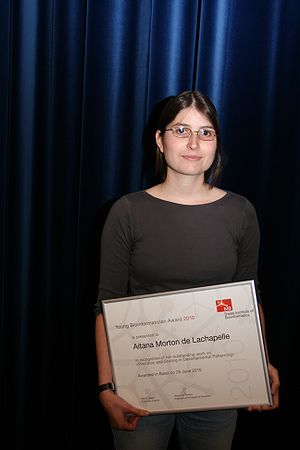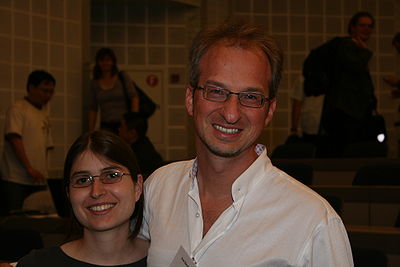Difference between revisions of "SIB Young Bioinformatician award 2010"
| (2 intermediate revisions by 2 users not shown) | |||
| Line 1: | Line 1: | ||
[[Category:Bulletins]] | [[Category:Bulletins]] | ||
| − | |||
<teaser> | <teaser> | ||
| − | On June 25 2010, during the 8th [BC]2 | + | On June 25 2010, during the 8th [BC]2 <a href="http://www.bc2.ch/">Computational Biology Conference</a> in Basel, <a href="http://www.isb-sib.ch/">SIB Swiss Institute of Bioinformatics</a> announced that CBG member [[Aitana Morton de Lachapelle]] is the winner of the <a href="http://www.isb-sib.ch/research/sib-awards/sib-2010-young-bioinformatician-award.html">SIB Young Bioinformatician Award 2010</a>. |
| − | |||
| − | |||
</teaser> | </teaser> | ||
Latest revision as of 17:07, 20 August 2012
On June 25 2010, during the 8th [BC]2 Computational Biology Conference in Basel, SIB Swiss Institute of Bioinformatics announced the winner of the SIB Young Bioinformatician Award 2010.
The winner is SIB Member Aitana Morton de Lachapelle, 27, PhD student in the Computational Biology Group led by Prof. Sven Bergmann at the Department of Medical Genetics of the University of Lausanne, which she joined after graduating in Physics from the EPFL (Swiss Federal Institute of Technology in Lausanne). During her PhD thesis, she has been investigating how robust pattern formation can be achieved during development.
Within a developing organism, cells need to know where they are in order to differentiate into the correct cell type. Pattern formation is the process by which cells acquire positional information and thus determine their fate. This can be achieved by the production and release of a diffusible signaling molecule, called a “morphogen”, which forms a concentration gradient: exposure to different morphogen levels then leads to different cell fates. Though morphogens have been known for decades, Mrs. Morton de Lachapelle explains that “it is not yet clear how these gradients form and yield such robust patterns. We have been investigating the properties of Bicoid and Decapentaplegic, two morphogens involved in the patterning of the anterior-posterior axis of Drosophila embryo and wing primordium, respectively”. In particular, she is interested in understanding how the pattern proportions are maintained across embryos of different sizes or within a growing tissue, which is essential to yield a correctly proportioned organism or organ. Ultimately, the general understanding of how cells respond to signals and coordinate their actions could bring new insights into some diseases like cancer and, theoretically, provide the ground to make artificial tissues.
In their published work, Mrs. Morton de Lachapelle and Prof. Bergmann investigated two systems properties of Drosophila early embryo development: using staining images for three gap genes and the pair-rule gene Eve, they investigated the precision and scaling of their expression domains. Their results suggest that these properties are, at least in part, already achieved at the level of the Bicoid gradient itself and then passed on to its target genes. Investigating models that can reproduce the position-dependent signatures of precision and scaling, they identified two necessary ingredients: it is essential to include nuclear trapping and an external pre-steady state morphogen gradient to achieve both maximal precision at mid-embryo and almost perfect scaling away from the source. Current work within the SystemsX.ch WingX collaboration aims at understanding how scaling can be achieved by the Decapentaplegic signaling pathway during wing imaginal disc growth.
The Young Bioinformatician Award is given yearly by SIB Swiss Institute of Bioinformatics. It recognises a graduate student or young researcher who has carried out a research project centered on the in silico analysis of biological sequences, structures and processes. The award is given competitively by a jury of experts and is doted with a cash prize of CHF 10'000.

